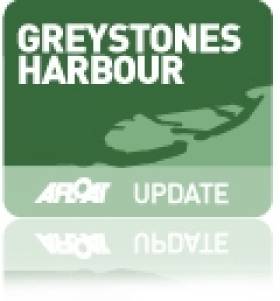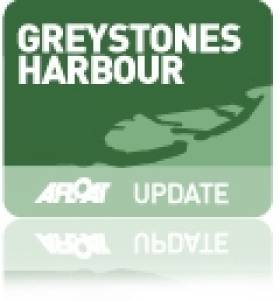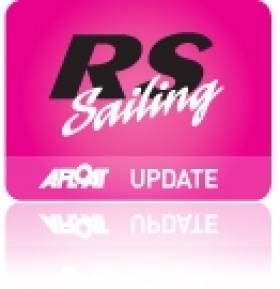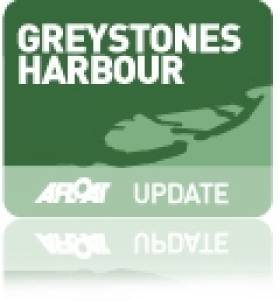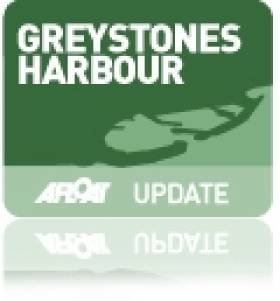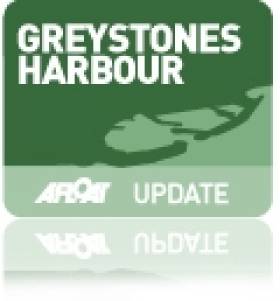Displaying items by tag: Greystones
Progress on Greystones Marina 'Slower than Hoped'
#MARINA – Inspite of the recent positive news about the opening of the interim harbour at Greystones there is still no more no more definite news on the planned marina there.
Developers Sispar, with assistance from Greystones Sailing Club, Greystones Motor YC and local Councillors are putting together a list of prospective users together with a view to holding a meeting to assess whether there is enough demand to justify putting pontoons down for next Summer's boating season. 'Progress on this has been slower than hoped', Councillor Derek Mitchell told Afloat.ie
Interim Harbour Opens at Greystones
#MARINA– Greystones Harbour developer is considering whether there is enough demand to open the planned Greystones marina next Summer following the opening of the interim harbour to the public last Saturday (November 5th).
Initial marina plans focussed on the installation of a 200-berth facility but subsequent market research cast doubt on whether the marina could be filled in the downturn. The research also showed that 80% of the berths required would be less than eight metres.
The new interim harbour consists of two public slipways, also beach launching facilities, boat compounds for the Sea Scouts, Rowers, Divers, Sailors and Anglers. The South Harbour Wall and the beach are now available for walking, opening it up for all to use according to Cllr. Derek Mitchell.
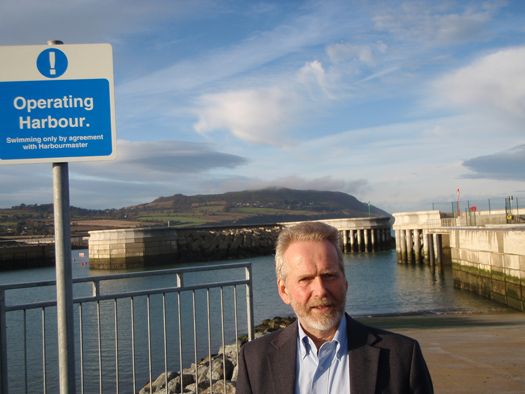
Councillor Derek Mitchell at one of the new slipways now open at Greystones harbour
‘The boat launching facilities are the best in the country and will provide adults and the youth with great sporting opportunities’. The photo shows Cllr Mitchell standing at the top of the new slipway, Mitchell said.
Nama have said they hope to make a decision soon as to whether to fund stage 2 consisting of the Primary Care Centre, five clubhouses and a much better quality finish for the Public Square than at present. The Coastguard and the Council are considering going to tender to construct the Coastguard station. ‘I hope these proceed soon so we can finish the job’ the Councillor added.
All Afloat's Greystones Harbour News here
Bottlenose Dolphins Living On Ireland's East Coast
The Irish Whale and Dolphin Group (IWDG) has said that evidence suggests a pod of three bottlenose dolphins is living on the east coast of Ireland.
According to RTÉ News, the organisation as validated close to 200 sightings of the dolphins - one of whom was spotted off Co Down in October 2010 - along the Dublin and Wicklow coastline in the last year.
The IWDG's Pádraig Whooley says that further analysis of theor movements show that they rarely travel north beyond Dalkey Island or south of Wicklow town, indicating a core range of 21 miles (33km).
"Remarkably, they seem to split their time evenly between their Dublin and Wicklow hotspots, thus making them extremely easy to locate, observe and photograph," he adds.
"In fact... the best way to find them other than checking this site, is probably to jump on a DART train in Dun Laoghaire bound for Greystones (or visa versa), making sure to look out the correct window."
While well known for being "boisterous, interactive and gregarious", bottlenose dolphins are also "indescriminate killers of porpoises and other dolphin species, with well-documented cases of infanticide".
Neither are they to be taken lightly by swimmers, with "a case load in Ireland of attacks on swimmers leading to serious injury, and at least one overseas case of [a bottlenose] killing a swimmer.
"It's nice to be able to boast of an apex predator lurking so close to the capital," says Whooley.
RTÉ News has images of the dolphins in action off the south Dublin coastline HERE.
Greystones Lead Both Fleets in RS 200/400 Irish Nationals
The championships, which were sponsored by Neil Mathews Architects, saw 18 RS400 boats and 13 RS200s enter. There were five races held over Friday and Saturday, while gusts of nearly 40 knots saw Sunday's races abandoned.
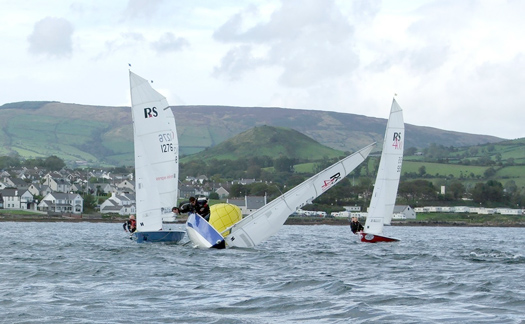
Local sailors John Lowry and Neil Diamond attempt to right their capsized RS400, while Greystones' Fiachra Etchingham and Eoghan Simpson pass the mark at the RS200/400 National Sailing Championships in Cushendall at the weekend
Roy Van Maanen and Glen Reid from Greystones Sailing Club led the RS200 fleet, bagging three firsts, a second and a third. In second place were Trevor Fisher and Heather King from Royal St George Yacht Club in East Down. And then it was Greystones again, with Sean Cleary and Steven Tyner amassing a first, second, third and two fourth place finishes to end up in third place overall.
Paul McLaughlin and Mick McKinley were first home from the five local crews that took part in the RS400 class, finishing fifth overall.
Gerry and Avril Cannon lifted a prize as the first mixed crew home in the 400s, while Sarah and Ciara Byrne in an RS200 were the first all-woman crew home.
Richard Doig and Dr Michael Hill from East Antrim Boat Club kindly officiated as Race Officer and Assistant Race Officer for the series.
RS 200: the 'ideal' next step for Irish Youth Sailing?
Questions over the next step for juniors after the RS Feva point to the bigger RS200 writes Feva sailor Ciara Byrne
The RSFeva has become the world's best selling two-person dinghy in recent years with fleets also growing in clubs all over Ireland. It is fast becoming the most popular and widespread choice for teenagers and youth sailors who enjoy competitive, active and exciting sailing.
However many questions were being asked recently at the RSFeva Nationals, held in Crosshaven, Co. Cork, regarding the next step for young, talented sailors who wish to continue racing in large fleets without the difficult transition of transferring from the Feva into a larger, unfamiliar dinghy. This uncertainty has led to many sailors dropping out of sailing altogether, while the remainder have split the fleet into Lasers, the 420/470 or moved on to cruisers.
However these dinghies require a lot of time and effort of getting used to, leaving some sailors frustrated and also, less motivated. To avoid this altogether, there is one simple solution: the RS200.
The RS200 is a spacious, one-design, double-handed, hiking, high-performance dinghy which has developed a huge following at club, circuit and championship level in the UK with a growing fleet in Ireland. A pivoting centreboard and rudder allow easy launch and recovery with a thwart giving the crew a comfortable position for light winds. With the asymmetric spinnaker, similar rigging and a similar design, it can be considered as a larger and faster Feva which makes for an easy changeover and the most logical and simple step up.
The ideal weight for an RS200 is 115-145kg (18-23 stone) which allows people of all ages to sail and race effectively in this dinghy. Ideal for teenagers emerging from the Feva, parents, youths, couples, friends and relatives can also come together which enhances the family and social scene.
Even though the 420 has a larger total sail area, the RS200's asymmetric spinnaker of over eight square metres, with a smoother single line hoist and drop system, similar to the Feva's. makes for a faster boat and requires greater tactical and more exciting downwind sailing. This encourages competitive racing and enhanced racing skills.

An RS200 at full speed off Greystones. Photo: Fiachra Etchingham
A maintenance free hull, made of lightweight polyester GRP ensures a long competitive life and second hand boats can be in very good condition so that older hulls are without the disadvantage experienced in fleets such as the 420. Furthermore, every hull comes from the same manufacturer giving no subtle advantage to any one boat; therefore racing just comes down to the sailors' tactics, boat handling and general knowledge of sailing and racing.
While the RS200 is not an Olympic class, there are large UK and Irish fleets which are active and competitive. Johnathan Lewis, a UK Feva coach and RS200 sailor, strongly encourages Feva graduates to move into the RS200 as it is an easy transition and makes for fun and exciting sailing. RS200 fleets are strong in Irish clubs such as those in Northern Ireland including Ballyholme, Newcastle and Cushendall as well as Greystones Sailing Club in Co. Wicklow.
Greystones Sailing Club boasts probably the largest asymmetric dinghy fleet in Ireland with fifty five asymmetric dinghies, twenty one of those being RSFevas and the majority of the remainder being RS200s. Recognising the RS200 as the natural progression from the Feva, ages range from fifteen to fifty five across the RS200 and RS400 fleets in the Club, with most of these boats competing in national events in Ireland, and some in the UK and further afield.

Rounding a mark in the RS200. Photo: Fiachra Etchingham
As fleets build in Dún Laoghaire and Howth yacht clubs, the RS200 is gradually becoming a popular progression from the Feva, and with the RS400 as a follow on boat for larger crews, young sailors can remain involved and spirited in asymmetric racing. The RS200 satisfies a thirst for speed and pace which generates more exciting, competitive and enjoyable sailing for those emerging from Feva fleet.
A Dublin Sailor (who has asked not to be named) has sent us comments on this story:
As one involved in junior and youth sailing at club level, one of the big decisions that faces youths is where to go after junior classes such as Optimists, Toppers, Fevas. Like any other sport, there is a high attrition rate after the age of 14 / 15, especially among girls which is an even greater shame as they can compete on a par with the guys.We need a class that will keep youths engaged. The 420 & 29er are great boats but require higher levels of boathandling, are much more competitive and tend to attract the top sailors. They also suffer from an inability to match up crews who will stick together - teenagers chop and change all the time and its difficult to race a boat like a 420 / Fireball / 29er wihout a constant crew partnership.
We need a boat/class that:
- Enables swapping around of crews without a major impact on the boathandling / teamwork. A sailor's plans for the weekend / event / season are not scuppered because of crewing issues.
- Does not need a highly competent crew (e.g. ability to trapeze and fly / gybe a kite etc.) so that sailors can sail with their mates who may not necessarily be top-notch sailors but who can acquit themselves well in a slightly less complex boat.
- Has a good mixed social scene which is the most important element of any class, youth or otherwise.
- Does not cost the earth in terms of purchase price, is easy on wear & tear on kit (hence replacement & upgrade costs) or does not go soft and become uncompetitive needing a new hull after three to five years etc
- Has international competition that is closeby (UK, FR, Bel, Ned etc) for those aspiring to a bit more
- Has a motiviated class structure to help grow the class.
The fear is that we are starting out another class that will dilute the current youth class efforts. However I believe that the 420 and 29er will hold their own and continue to attract top sailors with ISAF ambitions.
On the other hand, if we continue to support these we will continue to lose the middle ground (and majority) of young sailors from our sport. Youths are fickle enough and if its too much hassle to deal with all the challenges of getting afloat they just won't bother - sad but true.
The ISA needs to take a lead in this and while its Olympic ambitions are great to see, it will fail the sport as a whole if it does not tackle this gaping need in its portfolio of support.
I believe that the RS200 and R2400 provide the best solution to these challenges. They appear well-built and the manufacturer certainly appears well organised and gets involved.
Looking from outside and without any vested interests (other than the health of junior and youth sailing) the RS's get my vote as a class that can make a radical difference.
Howth Juniors Win 19-Boat Greystones Feva Event
Seven races were sailed and Howth visitors David Johnston and Louise Flynn Byrne emerged clear winners from Dun Laoghaire's Stephen Judge and Patrick Riordan by a margin of 12 points. Full results here.
The 'best public boat launching facilities in Ireland' will be provided in a final Greystones Harbour Plan released today, according to Fine Gael Concillor Derek Mitchell.
Having consulted with the community Sispar has produced their final plan for the Harbour for September and are currently implementing it, the Councillor says.
'This provides the best public boat launching facilities in Ireland even in this temporary solution. There is also good walking access to the area and South Pier together with car parking and green areas. To construct the Health Centre safely the hoardings at the North end will remain but the large green area there should open in a year, Mitchell, a winner in the Ruffian class in last week's VDLR sailing regatta, told Afloat.ie
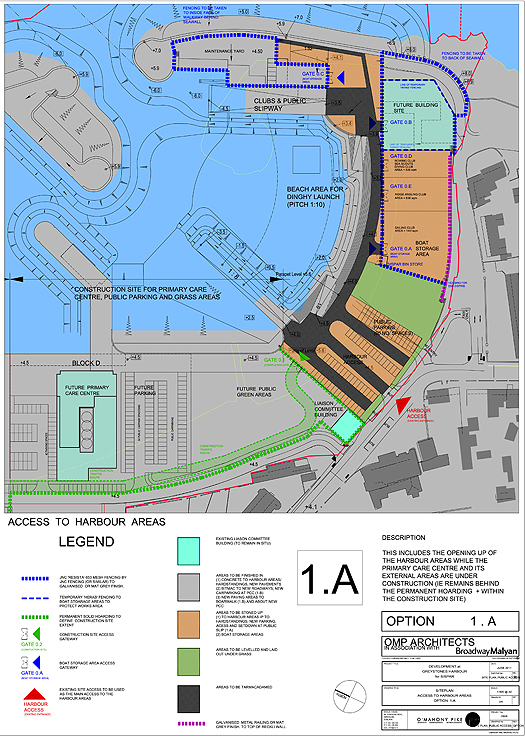
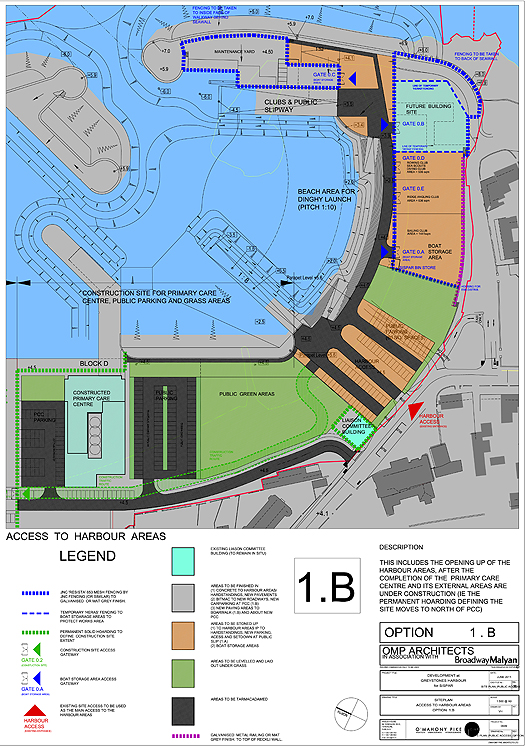
Drawings showing the proposed public access arrangements at Greystones Harbour. For higher resolution versions the pdf's are attached below.
'I am pleased they are implementing most of my plan and opposed to more meetings which will only delay implementation', he added.
Councillor Derek Mitchell says Greystones Harbour will be open in early September. The news follows a meeting between developers, Sispar, and the Town Council.
According to Mitchell, Sispar told a meeting of Town Councillors that they intend to open temporary facilities at Greystones Harbour by the end of August.
This will consist of:
· Taking down most hoardings and replacing with decorative railings thus opening up the views. The railings are already being made.
· Opening the harbour beach and second public slipway which is a calmer one.
· Fencing the entire area to be given to clubs for boat parking, greatly improving facilities for Anglers, Rowers, Sea Scouts, Divers and Sailors.
· Car Parking and wide access to the new South Pier.
· Starting building the Primary Health Centre by September 2011 and completing within 12 months. This will allow part of the public square to be finished.
· Provide some moorings.
· If there is no development of homes in 18 months time they will landscape the Public Park to the North.
They will review demand for the marina and hope to put in temporary facilities at least during 2012.
These items implement most of my plan and I welcome the good news of both good facilities and starting the Health Centre this year. There will be further consultation with harbour users and residents next week. The plan will then be finalised and implemented.
Parts of Greystones Harbour to Reopen to the Public
Parts of the paused development of Greystones Harbour are to be opened to the public, it has emerged.
According to The Irish Times, developers behind the €300 million plan are delivering a newsletter to residents in the Wicklow town listing its options for the harbour, the first phase of which was mostly completed this year.
These include landscaping parts of the site and reopening much of the area to public access while the second phase - which will include new facilities for clubs using the harbour - gets underway. Phase three is currently stalled dependent on funding.
Developer Sispar has already confirmed it will remove seconds of hoardings from around the harbour.
The Irish Times has more on the story HERE.
Greystones Harbour Group Urges 'Take Down The Hoardings'
A new residents group to push for progress on Greystones harbour has been formed. The 'Give Us Back Our Harbour' group says it has made substantial progress towards its objectives after it stepped up a campaign two weeks ago.
The GUBOH group has held several meetings with town and county councillors from all parties and has published the proposals it put to them to allow almost a kilometre of hoardings at the harbour development to come down and have the amenity returned to the public for the summer season.
"There has been great progress," said GUBOH spokesman Basil Miller. "We've met the Fianna Fail town councillors, including Greystones mayor Ciarán Hayden, Fine Gael's town and county councillors, and the Labour group which includes the Cathaoirleach of Wicklow County Council, Tom Fortune.
"All are agreed that something must be done to get the harbour amenity back to the people. All are agreed that it must be done soon. All are agreed that delegates from GUBOH must be included in any discussions with the developers on steps to make the harbour site safe, landscape it, and return the amenity to the people of Greystones."
Miller went on to say that there are disagreements on timing and on specific steps, but the overall level of agreement was "most encouraging".
"We are now quite optimistic, where ten days back we would have been 'cautiously optimistic'," he said. "Our proposals have, in their broad outline, been accepted by all parties. Issues have been raised, such as safety and insurance, which we acknowledge are important.
"But we believe that this kind of issue can be dealt with in meetings with the developers and WCC which will include GUBOH delegates, and we have told councillors this. Not every issue or objection need be resolved ahead of such discussions — we would expect suggestions for solutions to come from any party at the table, including Sispar or WCC."
He said that GUBOH has a pool of expertise both among its committee members and general membership which can help in such discussions.
"We can also call on external expert help. Several persons eminent in fields ranging from contract law to engineering to insurance and more have called us to volunteer their services. We can actually augment the expertise already available to WCC and Sispar with contributions from our own people, and we are happy to do so pro bono."
The local councillors have agreed that a GUBOH delegation should join in meetings with Sispar and WCC on the issues involved.
GUBOH has also begun a round of discussions with four local clubs in relation to the community facilities at the harbour which have also been delayed. The rowing club, angling club, sailing club and Sea Scouts will all move into new clubhouses and compounds at the south-‐east corner of the harbour, but nobody is able to say when these will be built or what the sequence for construction will
be.
And in the run-‐up to the Greystones Town Council meeting on Tuesday 31 May, at which Sispar will make a presentation on the harbour, GUBOH will also meet local TDs to seek their further support.
"It's not over till the fat lady sings, but we hope to see a united front of the community, the local councillors and the local TDs putting the point strongly that it is not acceptable for a ghost harbour and an empty building site to be left as it now is in the absence of any further building work," said Miller.
"To that end, we are ramping up our campaign another notch. Collectors will be on the streets in the area this weekend asking even more people to sign our petition. More premises will be displaying our banner.
"And more of our members and supporters will be attending the Town Council meeting, not in the form of a demonstration or protest, but simply to show Sispar and WCC that they stand behind us and behind our local representatives when they seek action to get the harbour back into public use."
Ten days ago, the group placed large banners on the walls of several business premises in Greystones as part of its campaign to have the harbour hoardings removed in time for the summer.
The banners bear the slogan "Give Us Back Our Harbour — Take Down the Hoardings".




























